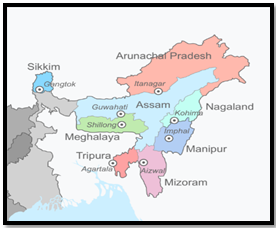HOW THE NORTHEAST EMERGED
Creation of ‘Northeast India’
- The term ‘Northeast India’ gained prominence in the 1970s.
- Enactment of two pivotal laws on December 30, 1971:
- North-Eastern Areas (Reorganisation) Act and
- North-Eastern Council Act.
Northeast Composition and Development
- Officially comprises eight states: Arunachal Pradesh, Assam, Manipur, Meghalaya, Mizoram, Nagaland, Sikkim, and Tripura.
- Part of the North-Eastern Council, a statutory advisory body for development planning.
Source: Wikimedia
Historical Background: ‘Frontier Province’ and Integration
- Colonial Assam was a ‘frontier province’ akin to the North West Frontier Province in British India.
- ‘Excluded areas’ acted as buffers between settled districts and international borders.
- Post-Independence, Northeast India faced unique governance challenges and security concerns.
Integration into Indian State and Governance Shift
- India’s postcolonial efforts transformed the imperial frontier into a national space.
- Concerns over national security intensified after 1947, with 98% of the region’s borders becoming international.
- 1960s marked by India-China war, Naga independence movement, and Mizo rebellion, prompting governance changes.
Legislative Changes (1971-1987)
- North-Eastern Areas (Reorganisation) Act (1971) led to Manipur and Tripura gaining statehood.
- Meghalaya and Mizoram emerged as states from autonomous districts in Assam.
- Arunachal Pradesh, formerly North East Frontier Agency, became a union territory, later achieving full statehood in 1987.
Impact of Naming and Identity
- Adoption of the directional name ‘Northeast’ reinforced a hierarchical relation between the region and the Indian heartland.
- Introduction of racialized categories like ‘Northeasterner’ led to identity challenges and stereotypes.
- The naming process, a result of muddling through without considering consequences, created as many problems as solutions.

 Source: Wikimedia
Source: Wikimedia

